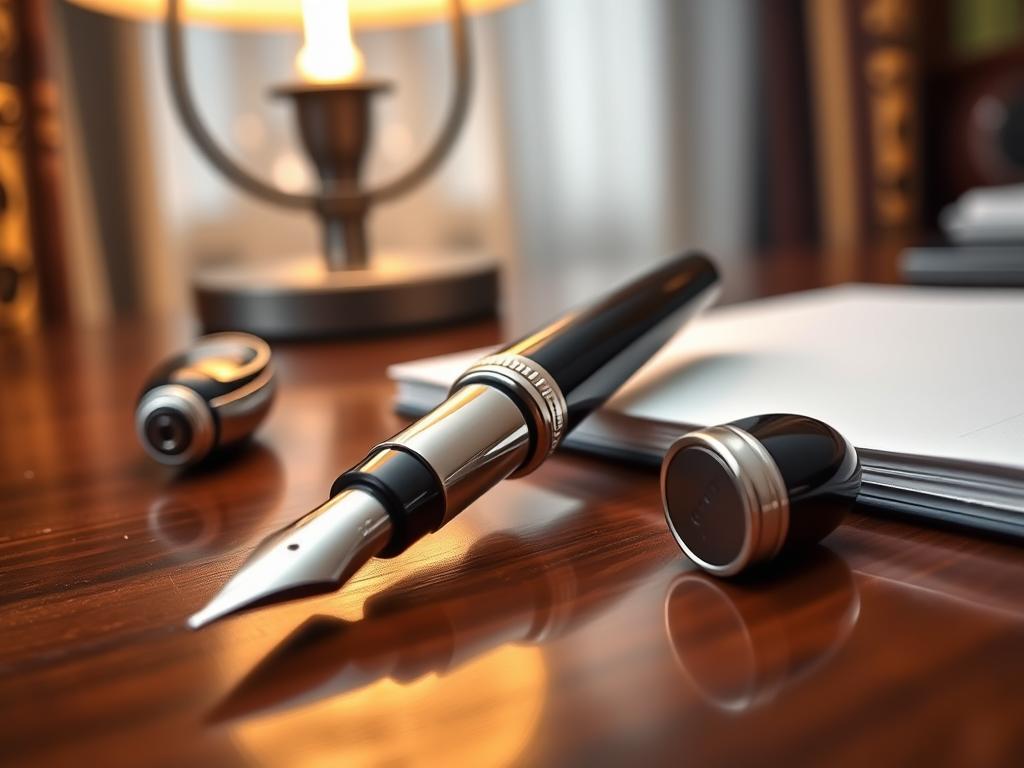Entering the world of high-end writing instruments can feel overwhelming. For first-time buyers, the shift from disposable pens to premium craftsmanship requires a thoughtful approach. Brands like Caran d’Ache and Montblanc represent more than tools—they blend art, engineering, and heritage into every stroke.
Focusing on quality over quantity helps avoid impulse buys. A carefully planned investment ensures you prioritize features that matter, like nib precision or ergonomic design. This mindset also encourages appreciation for details: the weight of a barrel, the flow of ink, or the elegance of hand-polished finishes.
The market for fountain pens has evolved, emphasizing timeless value over trends. Modern collectors seek pieces that tell stories through materials like resin or precious metals. Setting a realistic price range early simplifies decisions, whether you value durability or avant-garde aesthetics.
Key Takeaways
- Prioritize craftsmanship and functionality when selecting a premium writing instrument.
- Brands like Caran d’Ache and Montblanc exemplify the blend of artistry and engineering.
- Establishing a price range helps avoid overspending on unnecessary features.
- Focus on nib quality and ergonomic design for a personalized writing experience.
- The luxury pen market emphasizes long-term value through durable materials and heritage.
Understanding the Investment Behind Luxury Pens
High-end writing tools merge artistry with practicality, transforming everyday items into heirlooms. Unlike mass-produced alternatives, they demand meticulous attention to detail—from molten resin shaping to hand-tuned nibs. This dedication ensures each piece stands apart.

What Defines a Luxury Pen?
A premium instrument isn’t just about looks. Nib engineering plays a starring role. Brands like Montblanc use 18k gold nibs polished for hours to achieve seamless ink flow. Parker’s flagship models feature rhodium-coated accents, resisting tarnish while adding visual depth.
Materials matter too. Limited-edition fountain pens often incorporate celluloid or urushi lacquer—materials requiring months to cure. These choices elevate durability while honoring traditions. For instance, Nakaya’s hand-painted designs reference centuries-old Japanese techniques.
Cultural Significance and Craftsmanship
Fine writing instruments carry stories. S.T. Dupont’s lighter-inspired mechanisms nod to 1920s innovation, while Namiki’s maki-e art celebrates Edo-period aesthetics. Such details make them functional sculptures, appealing to collectors and creatives alike.
| Feature | Standard Pens | Luxury Pens |
|---|---|---|
| Nib Material | Stainless Steel | 18k Gold/Platinum |
| Production Time | Minutes | Weeks to Months |
| Resale Value | Low | Appreciates Over Time |
The market for these items thrives on scarcity. Graf von Faber-Castell’s annual editions sell out quickly, often doubling in value within five years. This blend of beauty and legacy explains why enthusiasts treasure them beyond mere utility.
Budgeting for Luxury Pen: Tips and Strategies
Navigating premium writing instruments requires balancing aspirations with practicality. Start by defining priorities: Will this piece become a daily companion or a display-worthy collectible? This clarity helps avoid overspending on features you might never use.

Determining Your Budget
Industry benchmarks suggest $500 as a common entry point, but first-time buyers can find quality below this mark. Assess functionality first—test nib smoothness and ink flow consistency. A $200 Lamy 2000 often outperforms pricier models in reliability, proving cost doesn’t always equal capability.
Seasonal sales and refurbished options offer hidden gems. Brands like Parker occasionally discount older collections without compromising craftsmanship. Limited editions might tempt, but ask: Does this design align with my style long-term?
Finding Affordable Yet High-Quality Options
Consider secondary markets for gently used pieces. Many enthusiasts sell well-maintained fountain pens at 30-40% below retail. Focus on brands known for durability, like Pilot’s Custom Heritage line, which combines stainless steel nibs with timeless aesthetics.
Allocate 15-20% of your budget for essentials: premium ink prevents clogs, while a quality case protects your investment. This approach ensures your chosen instrument ages gracefully, whether it’s a $150 TWSBI or a $600 Nakaya.
Remember, the best writing experience stems from harmony between hand and tool—not price tags. Test multiple grips and weights before committing. Sometimes, a $80 Faber-Castell Ambition delivers more joy than far costlier alternatives.
Exploring Top Luxury Pen Brands for First-Time Buyers
Selecting a premium writing instrument introduces you to brands that blend tradition with cutting-edge innovation. Each name carries distinct philosophies, from century-old craftsmanship to bold contemporary statements. Let’s explore standout options tailored to different priorities.
Timeless Classics and Enduring Quality
Caran d’Ache exemplifies Swiss precision with its hexagonal barrels and rhodium-plated nibs. Montblanc’s Meisterstück series, launched in 1924, remains a benchmark for balanced weight and ink flow. Parker’s Duofold line, crafted from vibrant acrylics, merges vintage charm with modern reliability.
Modern Masterpieces and Unique Designs
Namiki elevates fountain pens into art with hand-painted maki-e scenes inspired by nature. Nakaya’s urushi lacquer models require months of curing, creating hypnotic depth. Pilot’s Custom Urushi line features oversized nibs for silky-smooth strokes, proving innovation thrives alongside tradition.
Limited Editions & Investment Pieces
Graf von Faber-Castell’s annual editions, like the Intuition Platino Wood, sell out within weeks. Pelikan’s M1000 Raden Brilliant uses raden shell fragments for celestial shimmer. Aurora’s limited releases, such as the 88 Nebulosa, often gain 30% value in secondary markets within two years.
Whether drawn to heritage or avant-garde flair, your choice reflects personal taste. As one collector notes: “These instruments aren’t just tools—they’re conversations with history.” Prioritize what resonates: the tactile joy of a nib gliding across paper or the pride of owning a wearable masterpiece.
Evaluating the Value and Writing Experience
Choosing a premium writing instrument involves more than admiring its exterior. True value emerges when craftsmanship meets daily usability. A pen’s ability to inspire creativity or streamline workflows depends on how its tangible features align with individual needs.
Assessing Build Quality, Nib Precision, and Design
Start by examining materials. High-end instruments often use 18k gold nibs paired with resin or lacquer barrels. These combinations ensure durability while maintaining a balanced grip. Test the nib’s responsiveness by writing figure-eights—smooth transitions between thick and thin lines signal precision engineering.
Ink flow consistency matters. A well-tuned nib deposits ink evenly without skips or blobs. Brands like Pilot and Platinum achieve this through microscopic slit adjustments. Weight distribution also plays a role: a pen that feels light during quick notes might fatigue the hand in longer sessions.
| Feature | Entry-Level | Premium |
|---|---|---|
| Nib Material | Stainless Steel | Gold/Platinum |
| Ink Flow | Standard | Custom-Adjusted |
| Grip Comfort | Generic | Ergonomic Contouring |
Personal Preferences and Practical Use
Your writing style dictates ideal choices. Journalists favoring rapid notes might prefer springy nibs, while calligraphers seek rigid tips for controlled strokes. Grip diameter affects comfort—broader hands often suit wider barrels like those in Sailor’s King of Pens series.
Field tests reveal insights no catalog can. One collector noted: “My Nakaya’s urushi finish warms to the touch, making marathon writing sessions feel effortless.” Seek models offering versatility—a Pelikan Souverän’s piston filler works equally well for office memos and personal letters.
Ultimately, the best instruments balance technical excellence with emotional resonance. Whether sketching ideas or signing documents, the right tool elevates every mark from mundane to meaningful.
Conclusion
Selecting your first premium writing companion merges practicality with passion. By setting a clear price range and prioritizing craftsmanship, you ensure your choice reflects both personal style and lasting value. Brands like Montblanc and Pilot demonstrate how heritage and innovation coexist, offering instruments that range from daily workhorses to limited-edition collectibles.
Key factors—nib precision, material durability, and ergonomic design—transform ordinary tasks into moments of joy. Even modest investments, such as pen 150 models, deliver refined performance for notes or signatures. Testing grip comfort and ink flow remains essential, as these details elevate the writing experience from functional to unforgettable.
For those seeking expert guidance, resources like the craftsmanship-focused platform Noble Quills offer valuable insights. Whether you gravitate toward vintage charm or modern minimalism, every stroke becomes an act of personal expression. Ultimately, a well-chosen instrument isn’t just a tool—it’s a joyful journey through artistry, history, and the simple pleasure of putting thoughts to paper.
FAQ
What makes a fountain pen a luxury item?
Luxury fountain pens stand out due to premium materials like gold nibs, handcrafted details, and heritage brands like Montblanc or Nakaya. They blend precision engineering with artistic design, ensuring a refined writing experience that mass-produced pens can’t match.
How can someone find affordable yet high-quality options?
Brands like Lamy or Pilot offer entry-level models with smooth nibs and durable construction. Prioritize reputable retailers or secondhand markets for gently used pens from Waterman or Aurora, which retain quality at lower prices.
Which brands are best for first-time luxury pen buyers?
Timeless choices include Caran d’Ache for sleek designs and Parker for reliability. Modern enthusiasts might prefer Namiki’s lacquer artistry or Graf von Faber-Castell’s limited editions, which balance craftsmanship with collectible value.
Are limited edition pens worth the investment?
Pens from Pelikan or Montegrappa often appreciate in value due to rarity and artistry. However, focus on personal enjoyment first—limited editions like S.T. Dupont’s releases should align with your style and writing preferences.
How important is nib selection for the writing experience?
The nib dictates comfort and line variation. Brands like Tibaldi or Aurora offer customizable options, from extra-fine to stub nibs. Testing different sizes helps match your handwriting flow and pressure habits.
Do luxury pens require special maintenance?
Regular cleaning with pen-friendly solutions preserves ink flow. High-quality inks from brands like Cross or Diamine prevent clogging. Storing pens horizontally and avoiding extreme temperatures also extends their lifespan.


